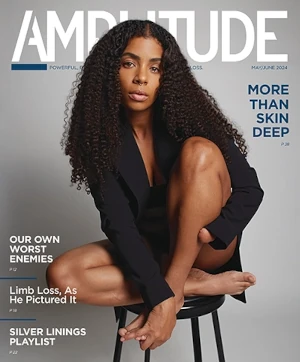
Two amputees I know had almost identical reactions when I told them Amplitude would be writing about Hollywood’s amputee stunt performers. “We’re all stunt performers,” they both said, laughing. One of them added: “I’ll have my agent call you.”
These were just brief exchanges, but they stuck with me as I worked on the article. I kept seeing parallels between the movie industry’s stunt professionals and the average person with limb difference going about their day.
For starters, on-camera daredevils all develop finely honed skills for risk management. It’s not that they avoid risk, because risk is unavoidable in their line of work. But they routinely anticipate hazards, large and small, and adjust their habits and decisions on a moment-by-moment basis to minimize the odds of a disastrous outcome. This ongoing process of assessment, calculation, and adaptation only occasionally rises to the level of conscious thought. But it’s always whirring in background mode, consuming at least a bit of mental bandwidth and battery power.
Sound familiar?
Another point of connection between Jane Q. Amputee and her Hollywood stunt counterpart is the ability to make difficult, highly choreographed maneuvers appear natural. This is why film credits no longer list these crew members as “stunt doubles” or “stuntmen/women.” They’re now listed as “stunt performers,” craftspeople who cultivate specialized skills and hone them over a lifetime. Audiences never see the training, the bumps and bruises, and the crazy engineering and technology that goes into creating the illusion. They just see a person doing something unexpected, incredibly cool, and marvelously real.
That, too, might sound somewhat familiar to you. The article is called “Crashing Through the Barriers,” and it starts on page 12.
Elsewhere in the magazine, we look at another group of risk-taking entertainers: comedians. You wanna talk about doing something that’s insanely unsafe? Try getting up in front of a room full of able-bodied people and getting them to laugh about limb difference. Now try doing it while simultaneously getting the audience to recognize society’s prejudices about disability, and perhaps even to acknowledge their own personal prejudices.
Given the choice between that stunt, or jumping off a moving train while it’s crossing a high bridge over shark-infested waters, many of us would take our chances with the latter. You’ll find the article, titled “Cracking Wise,” on page 23.
Diana Theobald is back in our pages this issue with a characteristically frank, funny article about her struggles to get physically active again after limb loss. We believe her story, “The Challenged Athlete” (page 28), is the first ever published that combines restorative yoga, orthopedic surgery, Daffy Duck, and the Twilight Zone within a single 2,000-word narrative.
Finally, if you’re brave enough to wade into the turbulent waters of the ever-changing market for bionic arms, we’ve got some tips about how to minimize your risks and maximize your rewards. See “Getting a Grip on the Bionic Marketplace,” beginning on page 18.
Happy summer!




